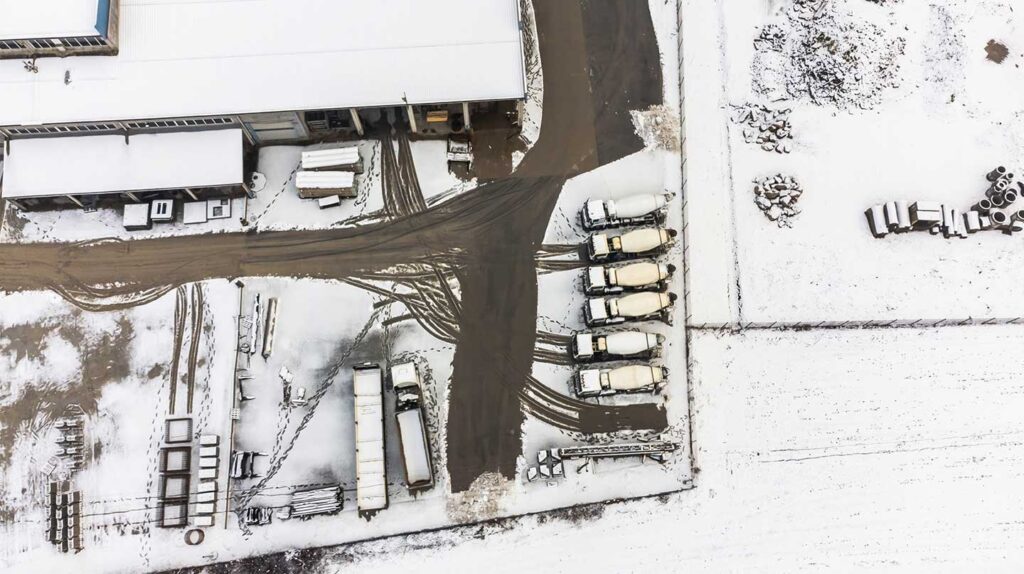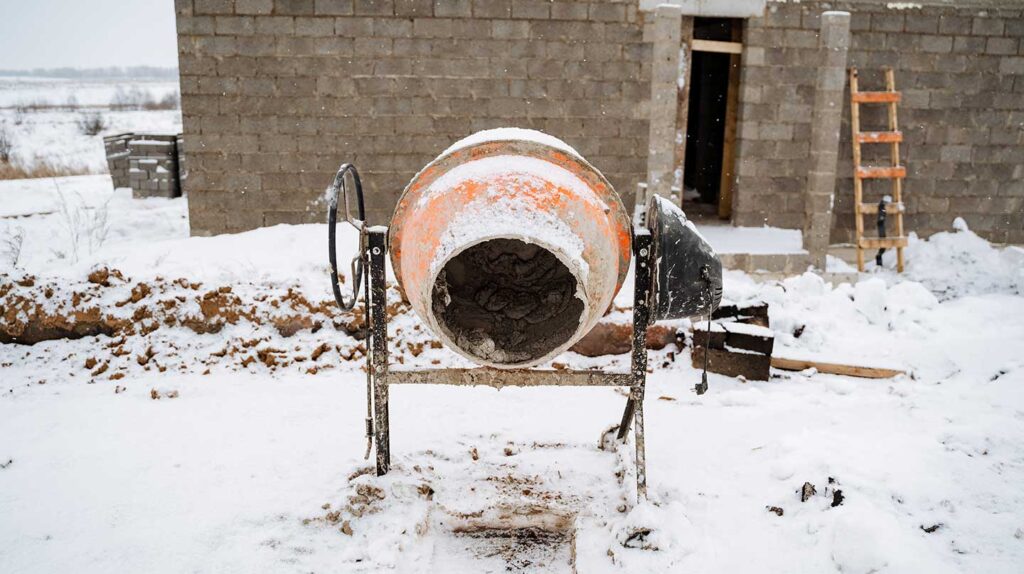
What Crews Should Know About Pouring Concrete in Cold Weather
The fall and winter months bring cooler temperatures and crisp air, a welcome relief for outdoor crews following the summer heat. With seasonal changes, however, come new challenges. Pouring concrete in cold weather can increase the risk of mechanical issues, safety concerns and potential problems with finished concrete products. Planning ahead, preparing equipment and helping team members approach projects prepared are all critical to keeping work on track and maintaining a safe job site.
Here, General Chipping’s concrete chipping experts share guidance to help crews go about pouring concrete in cold weather safely and effectively. From proper site prep to crew safety, these tips ensure your work stays productive, compliant and efficient, even when temperatures drop.
Can You Pour Concrete in the Winter and Late Autumn?
Crew members often wonder: Can you pour concrete in the winter without compromising quality? The short answer is yes, but doing so requires additional planning. The National Ready Mixed Concrete Association (NRMCA) recommends taking cold weather precautions whenever the average daily temperature stays below 40°F for three consecutive days or when temperatures drop below 50°F for more than 12 hours during a 24-hour period.
Concrete that freezes before it properly sets can lose up to 50% of its strength — a serious reduction that can affect both safety and long-term durability. Even near-freezing temperatures slow the curing process, which can lead to issues such as surface cracking, moisture infiltration and a weakened final product. To help ensure successful pours in colder months, consider the following:
Control the Temperature of Your Poured Concrete
While heating a full batch of concrete on-site is often impractical, you can preheat water and aggregate before mixing. Raising the concrete’s initial temperature helps it retain heat during curing. Once poured, crews can use windbreaks, enclosures and portable heaters to maintain a stable temperature. Concrete should remain in forms as long as possible to conserve heat and prevent moisture loss.
Keep the Surrounding Workspace Warm
Frozen or snow-covered ground can create hazards and slow work. Use portable heaters, heat blankets, heat pipes or insulated tarps to thaw work areas ahead of time. Ensuring a clear, workable site improves efficiency and reduces risks of slips, trips or equipment issues.
Monitor Humidity and Moisture Levels
Cold air tends to be dry, which can affect curing. Using steam, liquid membrane compounds or curing blankets helps crews maintain proper moisture levels and prevent cracking and structural issues in the finished product. Additionally, accelerating chemical admixtures in the concrete mix can improve curing time and strength in low temperatures.

Cold Weather Vehicle Maintenance Helps Keep Fleets Healthy
Proper cold weather vehicle maintenance plays a critical role in ensuring reliable, safe operations during fall and winter concrete work. Preparation should begin well before frigid conditions blow in, so ready mix trucks remain able to perform under more extreme circumstances. Here are some tips to help guide your efforts.
- Inspect Mechanical Components Regularly: Check tires, as cold weather reduces pressure. Examine hoses, belts, brakes, batteries and fluid levels. Consider using engine oil formulated for lower temperatures.
- Stock Emergency Supplies: Equip trucks with blankets, warm clothing, nonperishable snacks, road flares, cat litter and tire chains to prepare for snowy or icy conditions.
- Maintain Fuel & Hydration Systems: Ensure fuel filters are clean and antifreeze is at an appropriate level. Keep fuel tanks topped off to prevent condensation, which can freeze and block fuel lines.
- Clean & Protect Equipment Surfaces: Salt and ice buildup can accelerate corrosion. Wash trucks frequently and apply protective coatings where necessary.
- Monitor Vehicle Weight & Load Balance: Cold weather can impact suspension and handling, so ensure concrete loads are distributed properly to reduce strain on tires and axles.
- Keep Drum Walls Free of Buildup: Concrete residue inside drums reduces capacity, adds weight and can stress mechanical elements. Schedule professional concrete chipping appointments quarterly to maintain drum performance and avoid costly repairs and replacements.

Look After Your Complete System with Cement Silo and Central Mixer Care
Concrete operations rely on more than just redi mix trucks. Your cement silos and central mixers are integral parts of the system, and cold weather can impact their performance just as it affects trucks. Moisture can result in clogged silos, freezing temperatures can slow material flow and hardened residue in mixers can reduce efficiency and increase wear. Here are some ways to keep these elements healthy and serving you well.
- Silo Cleaning, Monitoring & Maintenance: Cold weather often causes cement to clump, leading to interruptions in material flow. Regular cleaning, monitoring moisture levels and maintaining proper insulation or heating can help prevent downtime.
- Central Mixer Maintenance: Similar to ready mix truck drums, hardened concrete inside central mixers can reduce capacity and affect the quality of a crew’s pours. Regular cleaning, including professional concrete chipping appointments, helps ensure your mixes remain consistent and your drums continue moving.
- Book Preventative Maintenance for All Components at Once: Although specific maintenance timelines will vary based on factors such as the type of concrete a crew pours, the age and brand of its vehicles and equipment, and the frequency of its work, industry experts recommend booking concrete chipping quarterly. Concrete chipping crews like ours typically tackle all three tasks — redi mix drum chipping, cement silo cleaning and chipping concrete from central mixers — in one appointment. This helps ensure every aspect of your system is ready to take on your team’s next project. Additionally, we recommend booking a full year’s worth of appointments out at once. That way, maintenance doesn’t go overlooked and companies avoid express chipping costs associated with last-minute appointments.
Keep Cold Weather Safety in Mind for Your Crew
A company’s workers are its greatest asset. It’s important to ensure team members are adequately equipped to take on seasonal work. Here are some cold weather safety tips to keep in mind to avoid injury, illness and unsafe scenarios.
Protect Your Crew from the Elements
- Build enclosures or install windbreaks of at least six feet around pour areas.
- Use portable heaters and humidity control to maintain a comfortable, safe working environment.
- Encourage layered clothing, gloves, insulated boots and water-repellent outerwear.
Plan Work Around Temperature and Daylight
- Schedule high-risk tasks during the warmest hours.
- Rotate crews frequently to avoid prolonged exposure to cold conditions.
- Provide warm, high-calorie meals and beverages to help crews maintain body heat. Advise crew members to avoid alcohol and excessive caffeine, which can impact circulation.
Promote Safety Awareness and Buddy Systems
- Encourage team members to work in pairs or small groups to monitor for early signs of cold stress.
- Train crews on recognizing symptoms of frostbite and hypothermia, and offer training on proper first aid procedures.
- Keep a clear line of communication between the site supervisor and team, and adjust work schedules based on weather changes.
Additional Cold Weather Safety Tips
- Inspect walking and driving surfaces for ice and snow. Apply sand or salt as needed.
- Ensure all equipment is properly de-iced before operation.
- Limit heavy lifting or strenuous work during the coldest periods to reduce strain.
- Maintain clear, accessible emergency exits in enclosed or temporary shelters.
Working through the colder months presents unique challenges for concrete crews, but with careful planning, proper cold weather vehicle maintenance and a focus on cold weather safety, quality results are within reach. If you have questions about any of the above, or if you’re interested in learning how General Chipping can help keep your crew ready to roll through the cold months and beyond, reach out at any time. Our team is always here to help.
